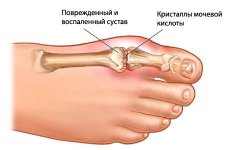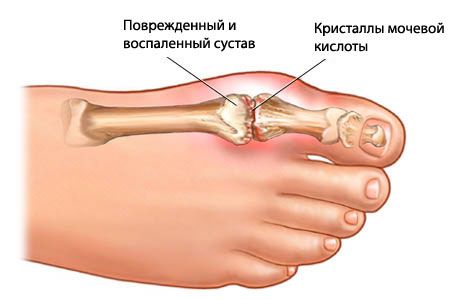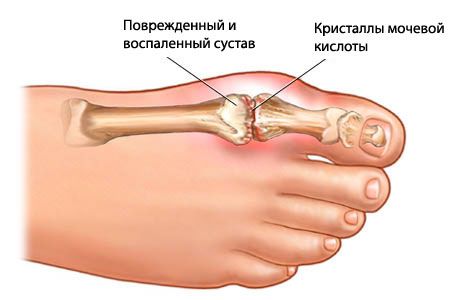
All iLive content is medically reviewed or fact checked to ensure as much factual accuracy as possible.
We have strict sourcing guidelines and only link to reputable media sites, academic research institutions and, whenever possible, medically peer reviewed studies. Note that the numbers in parentheses ([1], [2], etc.) are clickable links to these studies.
If you feel that any of our content is inaccurate, out-of-date, or otherwise questionable, please select it and press Ctrl + Enter.
Symptoms of gout in men and women
Medical expert of the article
Last reviewed: 04.07.2025

Gout is a disease that limits a person's movements and causes them to experience extreme pain in their legs. For example, due to attacks of gout, the world-famous military leader Kutuzov could not mount a horse without the help of soldiers. What are the symptoms of gout and how to fight this disease?

What is gout?
In short, this is a disease that takes a person in its claws due to a metabolic disorder. Namely, the metabolism of purines in the body is disrupted - substances that participate in the creation of DNA. And instead of them, uric acid accumulates, which causes wild pain in the limbs.
All these troubles are combined with attacks of arthritis in acute form, as well as accumulation of urates (these are salts of uric acid). That is why a person is very limited in movement and experiences pain in the limbs. That is why Kutuzov cannot mount a horse.
What are tophi?
Tophi are nodules in the joints that are hard to the touch and visible to the naked eye. Tophi are classic symptoms of gout when it becomes chronic. These nodules appear when a person has had gout for more than 5 years.
What are tophi made of? Connective tissue that surrounds hardened urate stones. The result is nodules. They can be located not only on the arms and legs, but also on the elbows, auricles, soles, thighs, forearms, shins, and even in the area of the nose – its cartilaginous septum.
These nodules are yellow and are immediately visible in areas affected by gout. During attacks of pain, tophi may no longer be so hard, they liquefy, and the fluid is released through small openings in the skin – fistulas. The only advantage of these small nodules is that they cannot become infected, since urates themselves are bactericidal and have antibacterial properties. What is released through the fistulas is an intense white color.
Causes of gout
If gout is defined as primary, the cause may be genetic changes - first of all - defects in protein molecules, or enzymes, which take a direct and active part in metabolism. To be more precise - without these molecules (enzymes), metabolism could not proceed normally. Protein molecules, first of all, accelerate chemical processes in the body.
In primary gout, genetically determined defects in enzymes involved in metabolism are often found
The genetic defect is also associated with hypofunction of the renal enzyme systems that regulate the excretion of uric acid. The development of gout is also facilitated by excessive nutrition, monotonous meat food, consumption of alcoholic beverages (especially beer, dry grape wines), and a sedentary lifestyle. The most common cause of secondary gout is kidney disease with renal failure, blood diseases (polycythemia, leukemia), accompanied by cell breakdown and hyperuricemia.
At-risk groups
These are mainly men over 40 years old. And if a person is already 50, the risk of developing gout increases 2-3 times. Why does gout love men the most? According to one theory, the occurrence of this disease is associated with a defect in the male chromosome. Therefore, the stronger sex suffers the most from the manifestations of gout. Men suffer from this disease 20 times more often than representatives of the weaker sex.
Gout is also associated with poor kidney function. Then this disease is classified as renal gout. That is, people with impaired kidney function are at risk. The connection between the kidneys and the gouty condition does not need to be looked for long - the kidneys are not able to cleanse the blood of protein products, so the blood flow slows down, there is a risk of depletion of the body's tissues of useful substances, and these tissues can hurt.
In addition, the level of uric acid increases in the blood, which is poorly purified - such small, seemingly innocent crystals. But these crystals are actually dangerous for humans, since they can make joints narrower in diameter. This means that the joints can no longer do their job well and signal this with pain, debilitating, long-lasting, unbearable. Inflammation of the joints and muscles located around them also joins the pain. Then inflammatory processes in the body are also accompanied by swelling.
People whose kidneys are not functioning well should pay attention to the condition of their joints - then gout can be stopped in its early stages, when the disease is not yet so insidious.
Gout associated with kidney disease
Attacks of gout may be combined with kidney stones, which causes joint and kidney pain to increase. Such pain is very common, occurring in 40% of patients. Kidney stones and gout symptoms may be aggravated by pyelonephritis.
Gout can be aggravated by another rather terrible disease - gouty nephropathy. This is a condition of the kidneys, when the kidneys cannot perform their functions. Renal failure can join this condition. An indicative symptom can also be high blood pressure, which is why patients can experience severe headaches, about a third of such patients.
Seven stages of gout
Gout manifests itself in 7 stages. Each of these stages has its own beginning, its own course and its own nature of pain. It is important for a person to know what is happening to him when he begins to have symptoms of gout.
Acute classic attack of gout
Why classic? Because these symptoms are typical for gout manifestations. They occur in 70-80% of cases. Most often, attacks overtake a person in the middle of the night. A person begins to feel weakness in the legs, arms, he is shaking, he cannot walk across the kitchen to drink a glass of water. In addition, severe headaches, arthralgia, subfebrile temperature are possible.
An indicator that a person has gout in its classic manifestation will be a sharp pain in the metatarsal phalanx joint, which is concentrated in the big toe. This joint swells very quickly, it can also be distinguished by the red skin, then the skin changes its shade to bluish-red, and the skin is shiny and hard to the touch.
The finger is hot at this time, it is painful to touch. Of course, in this state it is very difficult for the finger to move - it freezes in one position, wearing shoes is not possible at all.
The person's body temperature rises to 39 degrees, he has a fever. These are the manifestations of classic gout.
 [ 5 ], [ 6 ], [ 7 ], [ 8 ], [ 9 ]
[ 5 ], [ 6 ], [ 7 ], [ 8 ], [ 9 ]
What causes pain?
Foods with high fat content, alcohol overdose (severe intoxication), injuries to any part of the body, especially the lower extremities.
Duration of pain and attacks
From three to ten days. Then the pain subsides for a while and can resume after some time - a month, two, three, sometimes a year or two. At the time when the pain subsides, the swelling disappears, the joint begins to work normally, movements can be done with the same ease.
What happens in the body during an attack?
First of all, there is an inflammatory process in the body, which means that blood - our vital fluid - necessarily reacts to it. So, when analyzing blood, doctors detect an increased level of ESR, sialin acids, seromucoid, fibrin, and also detect C-reactive protein, which should not be present in a healthy state. C-reactive protein is a protein that appears in the blood as soon as inflammatory processes are detected in the body.
Attack of gout in men and women
If the attack of gout is the first time, then men may also have additional symptoms characteristic of arthritis. The joint of the big toe hurts, it also swells, and the metatarsophalangeal and tarsal joints suffer in the same way.
The wrist and elbow joints may also become inflamed, but this is an uncommon manifestation of gout. Very rarely, the joints of the pelvis, hips, shoulders, chest, and collarbone may become inflamed and painful.
But all these manifestations in men are manifestations of monoarthritis, that is, one part of the body from the above-mentioned ones becomes inflamed and hurts.
As for women, the doctor may diagnose polyarthritis - that is, multiple diseases of the joints of different parts of the body. Mainly, these are the hands (up to a third of women suffer from this pain!), as well as diseases and swelling of the ankle joints, metatarsus, knees, and wrist joints.
These symptoms can help men and women determine that they have gout and not a joint injury or something else.
 [ 12 ], [ 13 ], [ 14 ], [ 15 ], [ 16 ]
[ 12 ], [ 13 ], [ 14 ], [ 15 ], [ 16 ]
Subacute stage of gout manifestations

It manifests itself as monoarthritis (i.e. a disease of one joint). The joint of the big toe usually suffers the most. True, the pain is insignificant. Swelling and pain in the middle or large joint of the legs or arm are possible, this is more typical for young people under 30.
Rheumatoid gout
Its symptoms are damage to the joints of the hands, the smallest ones, or manifestations of monoarthritis, manifestations of polyarthritis, or attacks of pain in the joints, which can last for several hours or even days.
Pseudophlegmonous stage of gout
It is expressed as a monomanifestation of arthritis. It can be localized in any joint and tissues that surround it. High temperature - from 38 degrees - is also an expressive sign that a person has a pseudophlegmonous stage of gout. In addition, accompanying symptoms join the temperature: clearly expressed inflammation of one joint, fever, increased ESR in the blood, leukocytosis.
Gout of the allergic infectious polyarthritis type
This type of gout can bother a person in 5% of cases. That is, it is quite a rare form. Gout of the allergic infectious polyarthritis type can manifest itself as polyarthritis, but the localization of pain is not constant, but nomadic. Inflammation in this type of gout manifests itself very quickly, the inflamed joints are shiny and hard to the touch, can be of a frightening crimson hue.
Gout in the asymptomatic stage
With this type of gout, pain may be almost imperceptible, the inflamed joint bothers little, and the person often endures it without going to the doctor. This should not be allowed under any circumstances, you need to see a doctor even if the pain is not very strong. This form of gout can also be distinguished by hyperemia of the skin in the area where the joint is inflamed.
Gout in the periarthritic form
This disease involves pain that is localized in the tendons, most often in the Achilles tendon. It is dense to the touch and thickened. With each hour and day, if this form of gout is not treated, chronic polyarthritis with gouty overtones develops.
With this form of gout, the joints of the legs suffer the most, they become deformed. A person can no longer move as before, his movements are difficult due to severe pain in the joints. And their deformation occurs due to deposits in the joints, resembling nodules. Bone growths are also possible, fingers are now very easy to dislocate, they are no longer so mobile, a crunch is heard in them.
Patients with this form of gout move very poorly, they cannot work fully. Together with the joints, the muscles are also deformed, they are no longer as strong, they poorly support the joints. However, with frequent muscle contracture, ankylosis (complete immobility of the joints) occurs quite rarely.
With this form of gout, people should remember that they may experience acute attacks of pain, then these pains become chronic, as well as inflammation of the nearby muscle tissue. This happens due to the constant influx of urates - urine salts (in Greek, "urat" means urine).
Two forms of gout
There is primary gout and there is secondary gout. In the first case, this disease does not arise due to any other diseases, it is as if by itself (although everything in the human body is interconnected). In the second case - secondary gout - the culprits of the disease are other ailments: psoriasis, myeloleukemia, congenital heart disease, hemoglobinopathy and other diseases of the internal organs and blood. Secondary gout also includes its form, when a person uses certain drugs that affect the tissues of the body: cytostatics, drugs with riboxin, sauretics and other medications.
Who to contact?
What tests are done for gout?
A general blood test can determine whether there are inflammatory processes in the body; in addition, with gout, there will be an increased ESR in the blood.
Blood test for biochemistry - in gout, an increase in the level of sialic acids, haptoglobin, Y-globulins, alpha-2, as well as fibrin, uric acid is determined. An increased level of uric acid in the blood will be more than 0.12-0.24 mmol / l.
X-ray of all joints – this method helps to determine whether a person has chronic gout. If so, white spots will be visible on the screen, ranging in size from 0.5 mm to 3 cm in diameter. All these changes in the joints occur due to tophi, which you already know very well.
Tophi can be large, and then, when they are destroyed, they destroy the cortex of the joints. This phenomenon is called the symptom of swelling of the edge of the bone. When gout has been bothering a person for a very long time, the endocrine gland, which is also called the pineal body, can be destroyed almost completely. Instead, uric acid salts are formed in solid form - urates. They are visible on X-ray, but not at the initial stage, but no less than five years after the person fell ill with gout.
Synovial fluid analysis
Normally, the number of leukocytes should be from 1 to 15×109/l. Its color should be transparent, the synovial fluid should not be viscous. If a person has chronic gout, crystals of uric acid salts are clearly visible in the synovial fluid.
Tophi biopsy puncture
This method is used to find uric acid crystals in tophi, which can then be used to accurately determine that a person has gout.
 [ 17 ]
[ 17 ]

